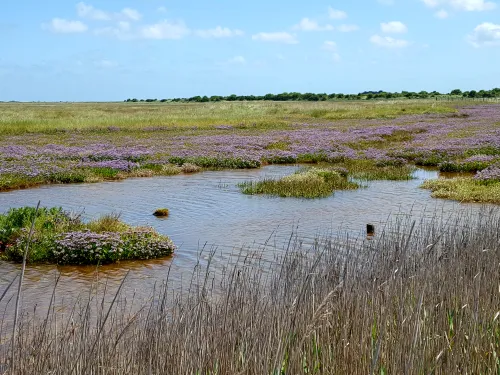
What my Kent Wildlife Trust membership means to me
Teacher, campaigner, and member Kerry Sabin-Dawson talks all about her membership journey in this blog.

Kent Wildlife Trust is a leader in the use of evidence in conservation practice.Bill Sutherland, Miriam Rothschild Chair in Conservation Biology, Conservation Science Group, Department of Zoology, University of Cambridge
Conservation Evidence is an online information resource designed to guide decisions on the best approaches for conservation practices. Based at the University of Cambridge, it encourages decision making to be led by evidence, so that conservation efforts return the greatest benefits for nature.
A key service provided by Conservation Evidence is a free online tool, the Conservation Evidence Database, which helps users to make decisions on conservation actions. Whether it's a decision on the best strategy for reducing the population size of an invasive species or how to create scrapes and pools in wetlands, their user-friendly tool supports the user through this process. The database could be used by a reserve warden who wanted to know the best approach to eradicate bracken from a heathland site, or a project leader who wanted guidance on how to best translocate a certain protected species. By summarising best-available evidence from published scientific studies, the tool makes it easy for the user to explore the best strategy. More specifically, the tool scores conservation actions on effectiveness, certainty, and potential harms, based on expert opinion to aid this decision-making process.
Within the realm of conservation publications, data can be outdated, poorly referenced, and lack a clear scope, so the Conservation Evidence team have also created a set of standards for publishing and sharing reports. The team encourages partners, like Kent Wildlife Trust, to test and publish conservation actions by following these standards, to expand the body of evidence available across the scientific community. By encouraging this practice, it proves highly valuable for enhancing our collective understanding of particular gaps in scientific research, while also assuring that the right approaches are being taken by both academics and conservation organisations. Their team provides guidance throughout this process, including the design of experiments, defining the project framework, and aiding the publication process.
Evidence-led conservation is one of the cornerstones of how Kent Wildlife Trust operates. We use evidence to strengthen our advocacy campaigns which protect precious sites from development, we use evidence to quantify potential impacts on wildlife and how to prevent or mitigate these, we use evidence to determine our impact in communities, schools and on our reserves, and of course, we use evidence to identify opportunities for landscape-scale ecosystem restoration and habitat creation to deliver a wilder Kent.
Conservation Evidence in practice is an ever-evolving field, and with tools such as the Conservation Evidence database, best practice guidelines and published papers detailing novel approaches to land management challenges can be easily accessed by practitioners. As an example, when planning and designing new wetland features for breeding and wintering wetland birds at Oare Marshes, Local Nature Reserve research was used to establish the best profiles. From the research, a new method of constructing the wetlands was used that avoids the need for removing or banking up material.
Part of our work over recent years has focussed on Chough reintroduction to Dover, which drew from a particular study accessed via the CE database. The paper was also used in the development of the FiPL Dover conservation grazing project, which will be undergoing a pilot study this year to replicate the study in Dover.
The continued development of the Monitoring and Evidence team has been vital, as much of the work undertaken at Kent Wildlife Trust is underpinned by evidence-led principles. In the new Monitoring and Evidence delivery plan, the aim is to facilitate and support the sharing and use of evidence in conservation practice at a whole Trust level. To this end, with support from the Digital Development team, we are building a SharePoint, allowing information to be shared more easily between departments for survey methodologies, and access to conservation evidence to inform management decisions.
Kent Wildlife Trust have delivered many successful projects through the years, and it continues to deliver high-impact projects which produce measurable outcomes. All this means is that, every project must be able to provide evidence of its success, in the form of qualitative or quantitative data. All projects are designed with some element of data collection involved, whether this is through citizen science, such as Bugs Matter, drone mapping and monitoring, or specialist surveys to help protected our landscape.
In 2023, as a part of its new M&E Delivery Plan, Kent Wildlife Trust established its Science Group, tasked with gathering, using, and communicating conservation evidence, mandated from Kent Wildlife Trust's trustees through to its staff. This cross-departmental group has now formed subgroups, which are addressing three key topics – ecosystem restoration, species recovery, and social science. Most relevant to our Champion status, is the work of the Ecosystem Restoration subgroup, who are developing a habitat transition matrix, to collate available evidence on best-practice in successful habitat transitions and restoration.
As part of this initiative, there is an ongoing, weekly ‘call for evidence’ internally, to collate knowledge and experience of our staff on particular habitat transitions. Simultaneously, we are using the Conservation Evidence database, and other published and grey literature, to collate external sources of evidence. There are several benefits of this work. Firstly, it will ensure we are using best available evidence for successful habitat restoration. Second, it will allow us to identify misalignment between our current and best-practice management. Third, it will serve as a valuable tool to inform choice of target habitat for restoration. Finally, it will serve as a useful resource for other conservation practitioners in the South East of England.


Teacher, campaigner, and member Kerry Sabin-Dawson talks all about her membership journey in this blog.

Natasha Ruskin explores something terrifying: a world without woodlands.

Ever wondered how planting trees or restoring soil can help fight climate change? Carbon sequestration is nature’s quiet housekeeping - learn more in this blog.